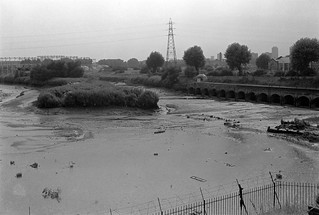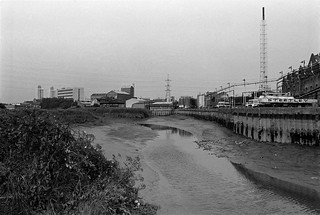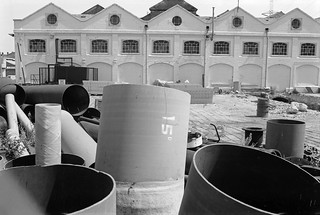The Channelsea River used to be a fairly important stream of the River Lea as it made its way down to Bow Creek, and the size of the bridge which carries the Northern Outfall Sewer over it close to Abbey Mills Pumping Station reflects this. Now in the few places that it remains visible it is little more than a ditch, and I couldn’t see any water flowing from it, and the Channelsea here is simply a tidal creek, often now called Abbey Creek.
Except for this row of openings. When heavy rain falls on London, it pours from the streets into the sewers, augmenting considerably their normal load of sewage. When the system was established in the Victorian era the flows were considerably smaller, but London has grown, with more people, more houses, more streets and more paved, concreted and tarmaced areas to rapidly drain away the water that might have once largely soaked into soil. The excess water (and not just water) has to go somewhere, and that somewhere is here on the Channelsea River.
Which certainly accounts for the lushness of the growth around the banks of the stream and on Channelsea Island and which was noticeable (along sometimes with a noticeable odour) as I walked along the path past the rather large pipe on the bank. To the right of the picture you can see a part of the pumping station, which back then was fairly well hidden behind vegetation as you walked along the ‘Greenway’ – you get a much better view now. And at the left are the Bromley-by-Bow gasholders, still present while many others in London have disappeared.
Looking across the Channelsea from beside that giant pipe showed an industrial landscape, now all gone. Channelsea House, the large six-storey 1960’s office block at right of the top picture, is now flats. But beyond it used to be large factories, including those making sulphuric acid, where there is now mainly empty space, with a small area now the London Markaz (Masjid-e-Ilyas), one of the biggest purpose-built mosques in London with space for 6,000 male worshippers.
These works stretched some way along the bank of the river and between it and the railway lines to the south, as you can see in the picture below, taken looking up the creek with Channelsea House at its left.
Immediately north of the bridge over the Channelsea River is the West Ham Sewage Pumping Station built in 1897 by West Ham Corporation to raise their sewage into the Northern Outfall Sewer. Previously they had released it into the creek. This contained three steam pumping engines which were decommissioned in 1972.
I didn’t photograph Abbey Mills on my walks along the Northern Outfall as it was hidden or largely so by the vegetation along the edge of the embankment, since largely cleared. But also a part of Bazalgette’s work were a row of houses on Abbey Lane built in 1865 for the workers at the pumping station, with steps at one end leading up to the path along the top of the Outfall.
Clicking on any of the pictures will take you to a larger version on Flickr from where you can explore other pictures in the album.
All photographs on this and my other sites, unless otherwise stated, are taken by and copyright of Peter Marshall, and are available for reproduction or can be bought as prints.
Tags: Abbey Mills, Bazalgette, Channelsea House, Channelsea River, chemicals, factories, Greenway, Lea Valley, Lee Valley, Northern Outfall Sewer, sewage, Steetley, Stratford, sulphuric acid, West Ham, workers housing







